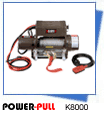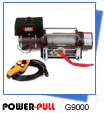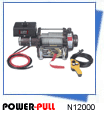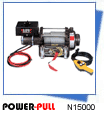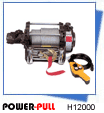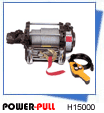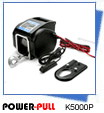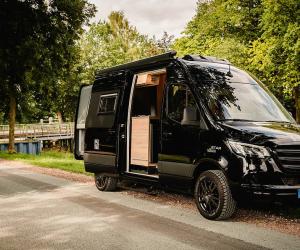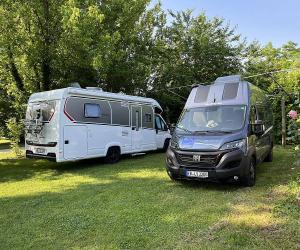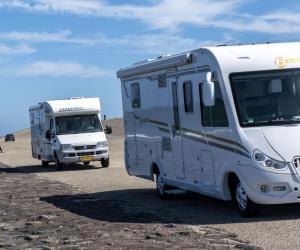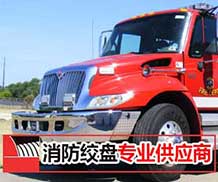EWP3500新型ATV电动绞盘深度解析
3500 Lb WINCH
Assembly&Operating Instruction

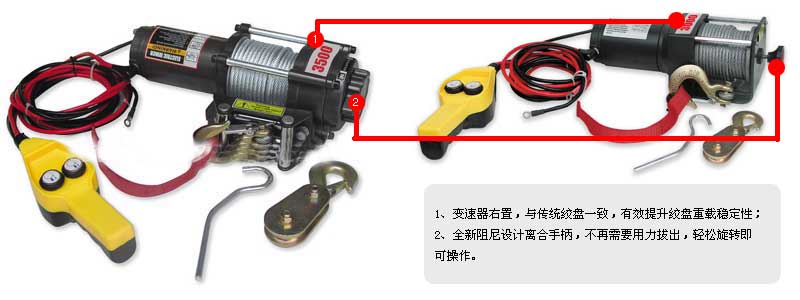
通过两代ATV绞盘的对比,可看出优化升级后的显著特点:
1、变速器右置,与传统绞盘一致,有效提升绞盘重载稳定性;
2、全新阻尼设计离合手柄,不再需要用力拔出,轻松旋转即可操作。
INTRODUCTION
!WARNING.Read,study and follow all instructions before operating this device.Failure to heed these instructions may result in personal injury and/or
property damage.
Your winch can develop tmmendous pulling forces and if used unsafely or improperly could result in property damage,senous injury or death.Throughout this manual you will find
the following symbols for caution.warning and danger.Pay particular attention to the notes preceded by these symbols as they are writlen for your safety. Ultimately,safe
operation of this device rests with you,the operator.
CAUTION
Indicates a potentially hazardous situation which,if not avoided,may result in minor or moderate injury.This notation is also used to alert against unsafe practices.
WARNING
Indicates a potentially hazardous situation which,if not avoided could result in death or serious injury.
INCLUDED WITH YOUR WINCH
DESCRIPTION
1.Winch Assembly with Wire Rope
2.Cap Bolt M8 x 30
3.Lock Washers
4.Flat Washers
5.M8 Nuts
6.Cte}vis Hook w/Pin
7.Control unit(three kinds of control mode for your choice)
7.1 ATV Switch
7.2 Wire Remote control Switch
7.3 Wireless Remote control
8.Hand Saver Hook
THE FOLLoWING DESCRIPTIONS ARE OPTIONAL
001.Pulley Block
002.Roller Fairlead and Screws
003.Mounting Channel Screws

WINCH ACCESSORIES YOU WILL NEED
NOT INCLUDED WITH YOUR WINCH
Gloves—For handling the wire rope and hook strap.
Anchor Strap/Chain——Tree saver anchor straps are made of high quality nylon with high tensile strengths from 5,000 t0 1 0,0001bs.
Heavy Blanket——place on the cable to absorb energy should the wire rope break.
GETTING TO KNOW YOUR WINCH
Your 35001b Champion Power Equipment winch is a powerful piece of machinery.It is important that you understand the basics of its operation and specifications so that when you
need to use it,you can use it with confidence and safety.Below is a list of the components of your winch and their use.Practices using your winch before you are in a
situation to need to use it.
1.Motor:Your l.0HP motor is powered by a l 2 volt battery and provides power to the gear mechanism which turns the drum and winds the wire rope;
2.Winch DnJm:The winch drum is the cylinder on which the wire rope is stored.It can feed or wind the rope depending on the remote winch switch.
3.Wire Rope:Your winch has a 7/32"x 49’galvanized aircraft cable designed specifically for load capacity of 3.5001bs.The wire rope feeds onto the drum in the“under wind”
position through the roller fairlead and is looped at the end to accept the clevis hook pin.
4.Roller Fairlead:When using the winch at an angle the roller fairlead acts to guide the wire rope onto the drum and minimizes damage to the wire rope from abrasion on the
winch mount or bumper.
5.Mechanic Gear System:The reduction gears convert the winch motor power into extreme pulling forces.
6.Braking System:Braking action is automatically applied to the winch drum when the winch motor is stopped and there is a load on the wire rope.The braking action is applied
by a separate mechanical brake.
7.Free Spooling Clutch:The clutch allows the operator to manually disengage (“Out”)the spooling drum from the gear train,free sp001.Engaging the clutch (“In”)locks the
winch into the gear system.
8 Solenoid:Power from the vehicle bakery flows through the weather sealed switch before being directed to the winch motor.
9.Remote Switch:6’Power switch Ieads has a duaI switch for powenng in or powenng out your winch drum.The 6’leads allow you to stand clear of the wire rope when the winch is
under load.
1 0.Universal Flat Bed Mounting Channel:Your winch has been optional supplied with a fiat bed mounting channel that can be mounted to most flat surfaces such as trailers,step
bumpers,truck beds,etc.The mounting channel also has holes to accept your roller fairlead.
1 1 Snatch Block:If Your winch were supplied with a snatch block that.used properly.can double the pulling power of winch,or change your pulling direction without damaging
the wire rope.We recommend you to use double line and snatch block for pulling over 2.500 Ibs/1134 kgs.
WINCH ASSEMBLY AND MOUNTING
1.Your C3。500 Ib winch is designed with a bolt pattem that is standard in this class of winch.Many winch mounting kits are available that utilize this bolt pattern for the
most popular ATV’s and mounting channels.If you cannot find a kit locally,contact CPE and we will provide you with the name of a dealer near yOu.
If you will utilize the CPE mounting channel you must ensum that it is mounted on a flat surrace so that the three major sections(motor,dnJm and gear housing)are properly
aligned.Proper alignment of the winch will allow even distribution of Ihe fu¨rated Ioad.
2.Start by connecting the Roller Fairlead(Part#3500500)to the Mounting Channel(Part#350029)usin9 2 each of the Cap Bolt M8 X 25(Part#350030), Flat Washer(Part#350028),Lock
Washer(Part#350027)and securing with M8 Nut(Part#350026)(Make sure the bolt is placed through the mounting channeI and roller fairlead from inside the channel.This wilI allow
enough clearance for the winch to be placed in the channel without obstruction.)
3.Assemble the winch to the Mounting Channel(Part#350029)by first pulling and releasing the clutch knob t0“Off,,position fFree Spooling).Pull out a few inches of cable fT.
om the dnJm and feed the wire loop through the opening in the front of the mounting channel and roller fairlead.Now,using the remaining M8 x 30 Cap Bolts(Part#350031),Flat
Washer(Part#350028),Lock Washer(Part#350027)and M8 Nut(Part#350026)secure the winch to the mounting channel.
4.Connect the battery(5’9”)leads.connect the red(Positive+)lead from the power switch to the positive(+)terminal of the vehicles l 2 volt bakery. Connect the black
(Negative-)lead from the power switch to the negative(-) terminal of the bakery.
!CAUTION—Batteries contain gases which are flammable and explosive.Wear eye protection during installation and remove all jewelry.Do not lean over battery while making
connections.
5.Assemble the Clevis Hook to the cable.Take off the pin from the Clevis Hook。 connect the Clevis Hook to the cable and mount the pin back to the Clevis Hook.
6.Always use the Hand Saver when free—spooling and re—spooling the wire rope. Using the Hand Saver will keeps your hands and fingers away from the rotating drum.
7.Check for proper drum rotation.turn the clutch knob to the“off'’position(Free—spooling).Pull out some cable from the drum.and then turn the clutch knob to the“In”
position to engage the gears.Left the Female connector cover exposing the electricn switch connecter.Insert the ATV Switch or Remote control switch or Wireless Remote control
Receiver connector into the Female connector.Press the cable out button on the power switch.If the drum is tuming and releasing more cable then your connections are accurate.
8.ATV Switch and Relay Mounting according to Winch Assembly Drawing.
SAFETY PRECAUTIONS
WARNING
!WARNING—DO NOT EXCEED RATED CAPACITY.
!WARNING..Intermittent use only.
!WARNING-Do not use winch in lifting or moving or persons.
!WARNING.A minimum of five wraps of cable around the drum barrel is necessary for pulling and holding the rated load.The cable clamp is not designed to hold the load without 5
wraps of cable around the barrel.
!WARNING-Keep yourself and others a safe distance to the side of the cable when under tension.
!WARNING—The wire rope may break before the motor stalls.For heavy loads at or near rated capacity,use a pulley block/snatch block to reduce the load on the wire rope.
!WARNING-Never step over a cable,or near a cable under load.
!WARNING-Don’t move the vehicle to pull a load(towing)on the winch cable.This could result in cable breakage.
!WARNING-Disconnect the remote control and battery leads when not in use.
!WARNING-Do not exceed maximum pull ratin9.Avoid“shock loads”by using the control switch intermittently to take up the slack in the wire rope.“Shock loads’’can far exceed
the rate capacity for the wire rope and drum.
!WARNING-Do not exceeds maximum line pull ratings shown on the tables.
!WARNING-When re-spooling the cable,ensure that the cable spools in the under-wind position with the cable entering the drum from the bottom, not the top.To re-spool
correctly,and while wearing gloves,keep a slight load on the cable while pushing the remote button to draw in the cable.Walk toward the winch not allowing the cable to slide
through your hands.Do not let your hands get within l 2”of the winch while re-spooling.Turn off the winch and repeat the procedure until a few feet of cable is left.
Disconnect the remote control and finish spooling by hand by rotating the drum by hand with the clutch disengaged.Keep handsclear of the fairlead and drum while the winch is
under power.
!Do not use as a hoist.Do not use for overhead liftin9.
!Failure to heed these warnings may result in personal injury and/or property damage.
!WARNING—Use gloves to protect hands when handling the cable.Never let the cable slide through your hands.
!WARNING—Never connect the cable back to Itself. Apply blocks to the wheels of the vehicle when on an incline. No modifications,alterations,or deviation to the winch are
authorized by the manufacturer and SHALL not be made. Duration of winching pulls should be kept as shon as possible.If the motor becomes uncomfortably hot to the touch,stop
winching immediately and let it cooI down for a few minutes.Do not pull for more than one minute at or near the rated load.
!CAUTION一Fi the motor stalls do not maintain power to the winch.Electric winches are designed and made of intermittent use and should not be used in constant duty applications
.
!CAUTION.Never release the free-spool clutch when there is a load on the winch.
!CAUTION.Use hand saver hook when handling the hook for spooling or un-spooling the wire rope.
GENERAL TIPS FOR SAFE OPERATION
The C3500 is rated at 3.500 Ibs.capacity when spooling the first rope layer on the drum.Overloads can damage the winch/motor/or wire rope.For loads over 2.500 Ibs.we
recommend the use of the pulley block/snatch block to double the wire rope line.The will aid in two ways:a)reduce the number or rope layers on the drum,as well as,b)reduce
the load on the wire rope by as much as 50%.When doubling the line back to the vehicle,affach to the frame or other load beanng part.
The vehicle engine should be kept running during operation of the winch to minimize baffery drain and maximize power and speed of the winch.If the winch is used for a
considerable time with the engine off the baEery may be drained and too weak to restart the engine
Get to know your winch before you actually need to use it.We recommend that you set up a few test runs to familiarize yourself with rigging techniques,the sounds your winch
makes under various loads,the way the cable spools on the drum,etc.
Inspect the wire rope and equipment before each use.A frayed or damaged rope shall be replaced immediately. Use only manufacturer’s identical replacement rope with the
exact specifications.
Inspect the winch installation and bolts to ensure that all bolts are tight before each operation.
Never connect the cable back to itself.This will cause cable damage.Always use a snatch block,sling or chain of suitable strength as shown in the iIlustrations.
Store the remote control inside your vehicle in a place that it will not be damaged.
Any winch that appears to be damaged in any way,is found to be worn,or operates abnormally SHALL BE REMOVED FROM SERVICE UNTIL
REPAIRED.
It is recommended that the necessary repairs be made by a manufacturer's authorized repair facility.
Pull only on areas of the vehicle as specified by the vehicle manufacturer.
Only attachments and/or adapters supplied by the manufacturer shall be used.
RIGGING TECHNIQUES

Self Recovery
Locate a suitable anchor such as a strong tree trunk or boulder.
Always use a sling as an anchor point.!CAUTION Do not attach the clevis hook back onto the cable as this could cause damage to the cable.As shown in Fig 3.1
!Do not winch from an acute angle as the wire rope will pile up on one side of the drum causing damage to wire rope and the winch.Fig 3.2
Short pulls from an angle can be used to straighten the vehicle.Long pulls should be done with the wire rope at a 90。angle to the
winch/ehicIe.
When pulling a heavy load,place a blanket or jacket over the wire rope five or six feet frOm the hook.In the event of a broken cable it will dampen the snap back.For
additional protection open the hood of the vehicle as shown in Fig 3.3
For pulls over l.0001bs,we recommend the use of the snatch block/pulley block to double line the wire rope.Fig 3.4
This reduces the load on the winch and the strain on the rope by approximately 50%.
!WARNING.Never use your winch for overhead hoisting or for lifting people or moving people.
RIGGING TECHNIQUES A-Z
a.Take time to asses your situation and plan your pull.
b.Put on gloves to protect your hands.
c.Disengage the clutch to allow free-spooling and also save bakery power.
d.Altach the hand saver hook to the clevis hook.
e.Pull out the wire rope to your desired anchor point using the hand saver hook.
f.Secure the clevis hook to the anchor point:Slin9,chain or snatch block.Do not attach the hook back onto the wire rope.
9.Engage the clutch.
h.Connect the remote controI to the winch.
i.Start your engine to ensure power is being replenished to the battery.
j.Power in the wire rope guiding the wire under tension to draw up the slack in the wire.Once the wire is under tension stand welI clear.Never step over the wire rope.
k Double check your anchors and make sure alI connections are secure.
1.Inspect the wire rope.Make sure there are at least 5 wraps of wire rope amund the winch drum.
m.Drape a blanket or jacket over the wire rope approximately 5 t0 6 feet from the hook.Open the hood for added protection.
n.Clear the area.Make sure all spectators all well back and that no one is directly in front or behind the vehicle or anchor point.
0.Begin winchin9.Be sure that the wire rope is winding evenly and tightly around the drum.The vehicle that is being winched can be slowly driven to add assistance to the
winching process.Avoid shock loads;keep the wire rope under tension.
P.The vehicle to be winched should be placed in neutral and the emergency brake released.Only release the brake pedal when under full tension.Avoid shock loads to the winch.
This can damage the winch,rope and vehicle.
q.The winch is meant for intermittent use.Under full load with a single line rig do not power in for more than a minute without letting the motor cool down for a few minutes
and then resume the winching operation.
r.The winching operation is complete once the vehicle is on stable ground and is able to drive under its own power.
s.Secure the vehicle.Be sure to set the brakes and place the vehicle in park.
1.Release the tension on lhe wire rope.The winch is not meant to hold the vehicle for long penods of time.
u.Disconnect the wire rope frOm the anchor.
v.Rewind the wire rope.Make sure that any wire already on the drum has spooled tightly and neatly.If not,draw out the wire and re-spool from the point where the rope is
tight.
w Keep your hands clear of the winch drum and fairlead as the wire rope is being drawn in.
x Secure the hook and hook strap
Y.Disconnect the remote control and store in a clean,dry place.
z.Clean and inspect connections and mounting hardware for next winching operation.
WAINT AINENCE
1.Periodically check the tightness of mounting bolts and electrical connections.Remove all dirt or coffosion and always keep clean.
2.Do not attempt to disassemble the gear box.Repaim should be done by the manufacturer or an authorized repair center.
3.The gear box has been lubricated using a high temperature lithium grease and is sealed at the factory.No intemaI Iubrication is required.
REPLACING THE WIRE ROPE
1.If the wire rope has become worn or is beginning to show signs of strands breakin9,it must be replaced before being used again.To do this,remove the defective rope by free
spoolin9.Remove the bolt(Part#350007)M5x5 0n the drum and release the rope.
2.Insert the end of the new rope and secure the M5 x 5 mm bolt tightly.
3.Engage the clutch and re—spool the new rope on the drum keeping tension on the rope as it spools.Ensure that the rope is respooling in the under wind position.
!wARNING-Only replace the wire rope with the identical replacement part recommended by the manufacturer.
TROUBLE SHOOTING
┏━━━━━━━━━━┳━━━━━━━━━━━━━┳━━━━━━━━━━━━━━━━━━━━━━━━┓
┃ SYMPTOM ┃ POSSIBLE CAUSE ┃ SUGGESTED ACTl0N ┃
┣━━━━━━━━━━╋━━━━━━━━━━━━━╋━━━━━━━━━━━━━━━━━━━━━━━━┫
┃ ┃-Switch Assembly not ┃Insert Switch Assembly all the way into ┃
┃ ┃ connected propedy ┃ the connector. 、 ┃
┃ MOtor does not ┃—Loose bakery cable ┃-Tighten nuts on all cable connections. ┃
┃ turnon ┃ cOnnectiOns ┃ ┃
┃ ┃-Solenoid malfunctioning ┃-Tap solenoid to loosen contacts.Apply ┃
┃ ┃ ┃ 1 2 vows to colI terminals directly.A ┃
┃ ┃ ┃ clicking indicates proper activation. ┃
┃ ┃ ┃一Replace Switch Assembly. ┃
┃ ┃.Defective Switch ┃一Check for voltage at armature port with ┃
┃ ┃ Assembly ┃ Switch pressed.If voltage is present. ┃
┃ ┃.Defective motor ┃replace motor. ┃
┃ ┃—Water has entered motor ┃-AIlow to drain and dry.Run in shOrt ┃
┃ ┃ ┃ bursts without load until completely dry. ┃
┣━━━━━━━━━━╋━━━━━━━━━━━━━╋━━━━━━━━━━━━━━━━━━━━━━━━┫
┃M0tor runs but ┃Clutch not engaged ┃Turn clutch to the“In”position.If problem ┃
┃ cable drum does ┃ ┃ persists,a qualified technician needs to ┃
┃ notturn ┃ ┃ check and repair. ┃
┣━━━━━━━━━━╋━━━━━━━━━━━━━╋━━━━━━━━━━━━━━━━━━━━━━━━┫
┃Motor runs slowly ┃.Insufficient curren£or ┃—Bakery weak.recharge.Run winch with ┃
┃ or without normaI ┃ voltage ┃ vehicle motor runnin9. ┃
┃ power ┃ ┃一Loose or coEoded battery cable ┃
┃ ┃ ┃ connections.Clean,tighten,or replace. ┃
┣━━━━━━━━━━╋━━━━━━━━━━━━━╋━━━━━━━━━━━━━━━━━━━━━━━━┫
┃Motor overheating ┃—Winch running time too ┃-Allow winch to cool down periodically. ┃
┃ ┃ long ┃ ┃
┣━━━━━━━━━━╋━━━━━━━━━━━━━╋━━━━━━━━━━━━━━━━━━━━━━━━┫
┃Motor runs il3 0ne ┃.Defective Switch ┃—Loose or corroded battery cable or motor ┃
┃ direction only ┃ Assembly ┃ cable connections.Clean and tighten. ┃
┃ ┃ ┃一Repair or replace switch assembly. ┃
┗━━━━━━━━━━┻━━━━━━━━━━━━━┻━━━━━━━━━━━━━━━━━━━━━━━━┛
WINCH ASSEMBLY DRAWING

WINCH PARTS LIST
┏━━━━━┳━━━━━━┳━━━┳━━━━━━━━━━━━━━━━━┳━━━━━━┓
┃ N0. ┃ Part # ┃ Qty ┃ Description ┃ ┃
┣━━━━━╋━━━━━━╋━━━╋━━━━━━━━━━━━━━━━━╋━━━━━━┫
┃ 1 ┃ 3500100 ┃ 1 ┃ Motor Assembly ┃ ┃
┣━━━━━╋━━━━━━╋━━━╋━━━━━━━━━━━━━━━━━╋━━━━━━┫
┃ 2 ┃ 350001 ┃ 4 ┃ Locking Washerφ8 ┃ ┃
┣━━━━━╋━━━━━━╋━━━╋━━━━━━━━━━━━━━━━━╋━━━━━━┫
┃ 3 ┃ 350002 ┃ 4 ┃ CapScrewM8X 30 ┃ ┃
┣━━━━━╋━━━━━━╋━━━╋━━━━━━━━━━━━━━━━━╋━━━━━━┫
┃ 4 ┃ 350003 ┃ 2 ┃ TieBar ┃ ┃
┣━━━━━╋━━━━━━╋━━━╋━━━━━━━━━━━━━━━━━╋━━━━━━┫
┃ 5 ┃ 350004 ┃ 1 ┃ Hexagonal Shaft ┃ ┃
┣━━━━━╋━━━━━━╋━━━╋━━━━━━━━━━━━━━━━━╋━━━━━━┫
┃ 6 ┃ 350005 ┃ 1 ┃ Front Bush Drum ┃ ┃
┣━━━━━╋━━━━━━╋━━━╋━━━━━━━━━━━━━━━━━╋━━━━━━┫
┃ 7 ┃ 350006 ┃ 6 ┃ Washer.Flatφ6 ┃ ┃
┣━━━━━╋━━━━━━╋━━━╋━━━━━━━━━━━━━━━━━╋━━━━━━┫
┃ 8 ┃ 350007 ┃ 1 ┃ ScrewM5 X 5 ┃ ┃
┣━━━━━╋━━━━━━╋━━━╋━━━━━━━━━━━━━━━━━╋━━━━━━┫
┃ 9 ┃ 350008 ┃ 2 ┃ CapScrewM6 X 65 ┃ ┃
┣━━━━━╋━━━━━━╋━━━╋━━━━━━━━━━━━━━━━━╋━━━━━━┫
┃ 10 ┃ 350009 ┃ 1 ┃ Drum ┃ ┃
┣━━━━━╋━━━━━━╋━━━╋━━━━━━━━━━━━━━━━━╋━━━━━━┫
┃ 11 ┃ 350010 ┃ 1 ┃ Rear Bush Drum ┃ ┃
┣━━━━━╋━━━━━━╋━━━╋━━━━━━━━━━━━━━━━━╋━━━━━━┫
┃ 12 ┃ 350011 ┃ 1 ┃ Front Thrust Washer ┃ ┃
┣━━━━━╋━━━━━━╋━━━╋━━━━━━━━━━━━━━━━━╋━━━━━━┫
┃ 13 ┃ 350012 ┃ 1 ┃ Gear input Sun ┃ ┃
┣━━━━━╋━━━━━━╋━━━╋━━━━━━━━━━━━━━━━━╋━━━━━━┫
┃ 14 ┃ 350013 ┃ 1 ┃ Gear Ring Output ┃ ┃
┣━━━━━╋━━━━━━╋━━━╋━━━━━━━━━━━━━━━━━╋━━━━━━┫
┃ 15 ┃ 3500200 ┃ 1 ┃ Gear Carrier Assembly ┃ ┃
┣━━━━━╋━━━━━━╋━━━╋━━━━━━━━━━━━━━━━━╋━━━━━━┫
┃ 16 ┃ 350014 ┃ 1 ┃ Gear Ring ┃ ┃
┣━━━━━╋━━━━━━╋━━━╋━━━━━━━━━━━━━━━━━╋━━━━━━┫
┃ 17 ┃ 350015 ┃ 1 ┃ Gear Housin9/End Bearing ┃ ┃
┣━━━━━╋━━━━━━╋━━━╋━━━━━━━━━━━━━━━━━╋━━━━━━┫
┃ 18 ┃ 350016 ┃ 1 ┃ Rear Thrust Washer ┃ ┃
┣━━━━━╋━━━━━━╋━━━╋━━━━━━━━━━━━━━━━━╋━━━━━━┫
┃ 19 ┃ 350017 ┃ 1 ┃ Clutch axes ┃ ┃
┣━━━━━╋━━━━━━╋━━━╋━━━━━━━━━━━━━━━━━╋━━━━━━┫
┃ 20 ┃ 350018 ┃ 1 ┃ Cam Clutch Gear ┃ ┃
┣━━━━━╋━━━━━━╋━━━╋━━━━━━━━━━━━━━━━━╋━━━━━━┫
┃ 21 ┃ 350019 ┃ 1 ┃ Spring ┃ ┃
┣━━━━━╋━━━━━━╋━━━╋━━━━━━━━━━━━━━━━━╋━━━━━━┫
┃ 22 ┃ 350020 ┃ 1 ┃ Cover Clutch Housing ┃ ┃
┣━━━━━╋━━━━━━╋━━━╋━━━━━━━━━━━━━━━━━╋━━━━━━┫
┃ 23 ┃ 350021 ┃ 4 ┃ CapScrewM6 X 20 ┃ ┃
┣━━━━━╋━━━━━━╋━━━╋━━━━━━━━━━━━━━━━━╋━━━━━━┫
┃ 24 ┃ 350022 ┃ 1 ┃ ORingSeal ┃ ┃
┣━━━━━╋━━━━━━╋━━━╋━━━━━━━━━━━━━━━━━╋━━━━━━┫
┃ 25 ┃ 350023 ┃ 2 ┃ Screw M5 X 15 ┃ ┃
┣━━━━━╋━━━━━━╋━━━╋━━━━━━━━━━━━━━━━━╋━━━━━━┫
┃ 26 ┃ 350024 ┃ 1 ┃ Clutch Handle ┃ ┃
┣━━━━━╋━━━━━━╋━━━╋━━━━━━━━━━━━━━━━━┫ ┃
┃ 27 ┃ 3500300 ┃ 1 ┃ ControI Box ┃ ┃
┣━━━━━╋━━━━━━╋━━━╋━━━━━━━━━━━━━━━━━╋━━━━━━┫
┃ 28 ┃ 3500400 ┃ 1 ┃ Cable Assembly ┃ ┃
┣━━━━━╋━━━━━━╋━━━╋━━━━━━━━━━━━━━━━━╋━━━━━━┫
┃ 29 ┃ 350025 ┃ 1 ┃ Hand Saver Bar ┃ ┃
┣━━━━━╋━━━━━━╋━━━╋━━━━━━━━━━━━━━━━━╋━━━━━━┫
┃ 30 ┃ 350026A ┃ 1 ┃ ATV Switch ┃ By Choice ┃
┣━━━━━╋━━━━━━╋━━━╋━━━━━━━━━━━━━━━━━╋━━━━━━┫
┃ 31 ┃ 350026B ┃ 1 ┃ Wire Remote ControI Switch ┃ By Choice ┃
┣━━━━━╋━━━━━━╋━━━╋━━━━━━━━━━━━━━━━━╋━━━━━━┫
┃ 32 ┃ 350027—1 ┃ 1 ┃ wireless Remote Control Receiver ┃ By Choice ┃
┣━━━━━╋━━━━━━╋━━━╋━━━━━━━━━━━━━━━━━┫ ┃
┃ 33 ┃ 350027.2 ┃ 1 ┃ Emitter ┃ ┃
┣━━━━━┻━━━━━━┻━━━┻━━━━━━━━━━━━━━━━━┻━━━━━━┫
┃ OotionaI Not Enclosed ┃
┣━━━━━┳━━━━━━┳━━━┳━━━━━━━━━━━━━━━━━┳━━━━━━┫
┃ 34 ┃ 350028 ┃ 4 ┃ Hex Flange Nut M8 ┃ ┃
┣━━━━━╋━━━━━━╋━━━╋━━━━━━━━━━━━━━━━━╋━━━━━━┫
┃ 35 ┃ 3500500 ┃ 4 ┃ Locking Washer 08 ┃ ┃
┣━━━━━╋━━━━━━╋━━━╋━━━━━━━━━━━━━━━━━╋━━━━━━┫
┃ 36 ┃ 350029 ┃ 4 ┃ Thick Flat Washer φ8 ┃ ┃
┣━━━━━╋━━━━━━╋━━━╋━━━━━━━━━━━━━━━━━╋━━━━━━┫
┃ 37 ┃ 3500600 ┃ 1 ┃ Roiler Faidead ┃ ┃
┣━━━━━╋━━━━━━╋━━━╋━━━━━━━━━━━━━━━━━╋━━━━━━┫
┃ 38 ┃ 350030 ┃ 1 ┃ Mounting Channel ┃ ┃
┣━━━━━╋━━━━━━╋━━━╋━━━━━━━━━━━━━━━━━╋━━━━━━┫
┃ 39 ┃ 350031 ┃ 1 ┃ SnaItch Block ┃ ┃
┣━━━━━╋━━━━━━╋━━━╋━━━━━━━━━━━━━━━━━╋━━━━━━┫
┃ 40 ┃ 350032 ┃ 2 ┃ CapScrewM8 X 25 ┃ ┃
┣━━━━━╋━━━━━━╋━━━╋━━━━━━━━━━━━━━━━━╋━━━━━━┫
┃ 41 ┃ 350033 ┃ 2 ┃ CapScrewM8 X 30 ┃ ┃
┗━━━━━┻━━━━━━┻━━━┻━━━━━━━━━━━━━━━━━┻━━━━━━┛
Rated line pulls: 3500lbs(1587kgs)
Gear reduction ratio: 170:1:
Motor: PerrTlanent magnet DC l 2V motor with l hp output:
OveralI dimensions: 12.4”(L)X4.35”(W)X 6.1"(H);315(L)x 110(w)X 155(H)mm
Drum size: 1.46”(D)X 3.15”(L);37(D)X80(L)mm
Cable: 46'(L)of7/32”(D);14m(L)of 5.4 mm(D)
Weight: 23 Ibs/10.5 kgs
DUTY CYCLE
Line speed and motor current(First layer)
┏━━━━━━┳━━━━━━━━━━━┳━━━━━━━━━┓
┃ ┃ Line speed ┃ Motor current ┃
┃ Line pulI ┃ ┃ ┃
┃ ┃ ft/min(m/min) ┃ Amps(Max) ┃
┣━━━━━━╋━━━━━━━━━━━╋━━━━━━━━━┫
┃ Ib(kgs) ┃ 12VDC ┃ 12VDC ┃
┣━━━━━━╋━━━━━━━━━━━╋━━━━━━━━━┫
┃ 0 ┃ 9.0(2.8) ┃ 20 ┃
┣━━━━━━╋━━━━━━━━━━━╋━━━━━━━━━┫
┃ 500(227) ┃ 7.5(2.3) ┃ 50 ┃
┣━━━━━━╋━━━━━━━━━━━╋━━━━━━━━━┫
┃ 2000(907) ┃ 5.9(1.81 ┃ 100 ┃
┣━━━━━━╋━━━━━━━━━━━╋━━━━━━━━━┫
┃ 3500(1588) ┃ 2.o(0.6) ┃ 160 ┃
┗━━━━━━┻━━━━━━━━━━━┻━━━━━━━━━┛
Line pull and cable capacity
┏━━━━┳━━━━━━━━━━━━━━┳━━━━━━━━━━━┳━━━━━━━━━━━━━┓
┃ Layer ┃ ┃ ┃ ┃
┃ of ┃ Rated line pull per Layer ┃line speed per Layer ┃Cable capacity per Layer ┃
┃ cable ┃ Ib(kgs) ┃ ft/min(m/min) ┃ ft(m) ┃
┣━━━━╋━━━━━━━━━━━━━━╋━━━━━━━━━━━╋━━━━━━━━━━━━━┫
┃ 1 ┃ 3500(1588) ┃ 9.2(2.8) ┃ 7.9(2.4) ┃
┣━━━━╋━━━━━━━━━━━━━━╋━━━━━━━━━━━╋━━━━━━━━━━━━━┫
┃ 2 ┃ 2790(1265) ┃ 11.5(3.5) ┃ 1 7.2(5.2) ┃
┣━━━━╋━━━━━━━━━━━━━━╋━━━━━━━━━━━╋━━━━━━━━━━━━━┫
┃ 3 ┃ 2319(1052) ┃ 13.8(4.2) ┃ 27.0(8.3) ┃
┣━━━━╋━━━━━━━━━━━━━━╋━━━━━━━━━━━╋━━━━━━━━━━━━━┫
┃ 4 ┃ 1984(900) ┃ 16.1(4.9) ┃ 38.0(11.6) ┃
┣━━━━╋━━━━━━━━━━━━━━╋━━━━━━━━━━━╋━━━━━━━━━━━━━┫
┃ 5 ┃. 1734(786) ┃ , 18.7(5.7) ┃ 41.0(15.0) ┃
┗━━━━┻━━━━━━━━━━━━━━┻━━━━━━━━━━━┻━━━━━━━━━━━━━┛


